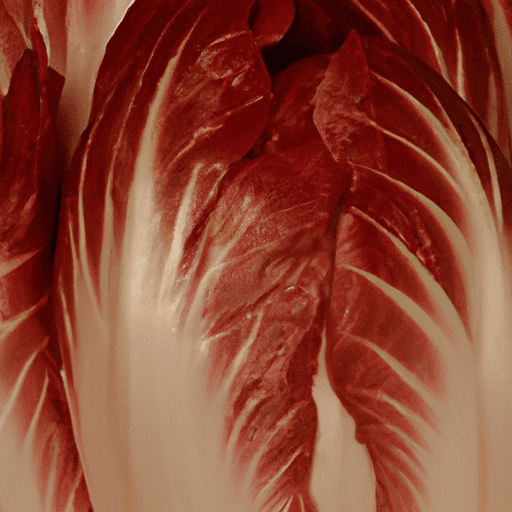Rediscovering the Delights of Red Belgian Endive
When it comes to unique and versatile vegetables, red Belgian endive stands out as a delightful addition to any menu. With its vibrant colors, delicate bitterness, and impressive nutritional profile, this culinary gem can elevate any dish. Join me as we delve into the world of red Belgian endive, exploring its taste, common uses in cooking, nutritional value, and uncovering some interesting history and facts.
Taste that Tickles the Palate
Red Belgian endive is prized for its refreshingly crisp texture and subtly bitter flavor profile. Its leaves offer a balance of sweet and tangy notes, adding complexity to various recipes. The vibrant red hue of the outer leaves hints at the satisfying crunch and slightly sweeter taste that lies within. This vegetable’s ability to deliver layers of flavor makes it a tempting choice for both raw and cooked dishes.
Endless Culinary Possibilities
Red Belgian endive offers endless possibilities in the kitchen, making it a go-to ingredient for both professional chefs and home cooks alike. Its tender leaves make for a refreshing addition to salads, adding a distinct crunch and a hint of bitterness that contrasts beautifully with other ingredients. Simply drizzle with a zesty vinaigrette and top with some crumbled cheese or thinly sliced fruits for a tantalizing salad experience.
When cooked, red Belgian endive reveals its versatility yet again. Its robust constitution allows it to hold up well to various cooking methods, such as grilling, roasting, or even braising. Grilled red Belgian endive develops a delightful smoky flavor, while roasting brings out its natural sweetness. Alternatively, braising this vegetable with a touch of honey or balsamic vinegar creates a mouthwatering caramelized finish.
Nutritional Powerhouse
Beyond its remarkable taste and culinary charm, red Belgian endive packs a nutritional punch too. Low in calories and rich in dietary fiber, it makes for a guilt-free addition to any diet. This vegetable is also an excellent source of vitamins A, C, and K, as well as essential minerals like potassium and calcium. Moreover, red Belgian endive contains beneficial antioxidants that promote overall well-being and aid in maintaining a healthy immune system.
A Fascinating History
The story of red Belgian endive is as captivating as its taste. The production of this vegetable dates back to the 1800s in Belgium, where it was discovered by accident. Legend has it that a Belgian farmer unintentionally left chicory roots in his cellar while seeking to preserve them. To his surprise, he found that the roots sprouted tender, pale shoots, which came to be known as red Belgian endive.
Since its accidental discovery, red Belgian endive has gained popularity worldwide and has become an essential ingredient in various cuisines. Today, Belgian farmers meticulously cultivate this vegetable using traditional methods, ensuring that its unique qualities are preserved for aspiring chefs and discerning palates alike.
Rediscover the Joy of Red Belgian Endive
Whether sprinkled on a vibrant salad, gently sautéed, or creatively incorporated into your culinary creations, red Belgian endive is truly a versatile superstar. From its enticing taste to its numerous health benefits and intriguing history, this delightful vegetable deserves a special place in your kitchen. So, embark on a culinary adventure and rediscover the joy of incorporating red Belgian endive into your recipes. Your taste buds will thank you!
Disclaimer: While red Belgian endive is generally safe for consumption, individuals with specific dietary concerns or medical conditions should consult with a healthcare professional before making any significant changes to their diet.
Remember, the world of food is an endless journey of discovery! Don’t be afraid to explore new ingredients and flavors. Happy cooking!
Red Belgian Endive
Origin: Red Belgian endive (Cichorium intybus) is a leafy vegetable derived from a plant called chicory, which is native to Western Asia, Europe, and North Africa. It was initially cultivated in Belgium in the mid-19th century, where it was later developed into the popular red-colored variety.
Common Uses: Red Belgian endive is highly versatile and can be used in various culinary applications. Its mildly bitter and crisp leaves make it perfect for salads, adding depth and texture to dishes. Additionally, it can be grilled, braised, or sautéed, which helps to mellow the bitterness and soften its texture. Red Belgian endive also pairs well with rich flavors, such as cheese, nuts, and cured meats, making it a popular ingredient for appetizers and hors d’oeuvres.
Nutritional Benefits: Red Belgian endive is low in calories and carbohydrates, making it a healthy addition to any meal. It is a good source of fiber, which aids in digestion and helps maintain a healthy weight. It also contains vitamins A and K, which are essential for maintaining healthy vision, bone health, and blood clotting. Additionally, red Belgian endive provides small amounts of minerals like calcium, potassium, and iron.
Unique Properties: Red Belgian endive possesses a unique natural color that sets it apart from other varieties of endive. Its leaves have a vibrant red hue, which not only adds visual appeal to dishes but also signifies its slightly sweeter taste compared to its green counterpart.
Historical Significance: The discovery of red Belgian endive was accidental. In the mid-19th century, a Belgian farmer accidentally left chicory roots in his dark cellar for a prolonged period. When he revisited the cellar, he discovered that the roots had sprouted pale white leaves in the absence of light. Intrigued by the discovery, he refined the cultivation process and developed the red Belgian endive. Since then, it has become a cherished and widely cultivated vegetable throughout Europe and beyond.




Use the share button below if you liked it.
It makes me smile, when I see it.